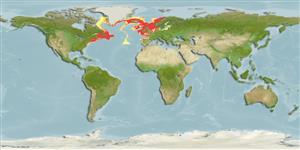Environment: milieu / climate zone / depth range / distribution range
Écologie
marin démersal; océanodrome (Ref. 51243); profondeur 18 - 1570 m (Ref. 5951), usually 45 - 366 m (Ref. 6263). Temperate; 2°C - 6°C (Ref. 6263); 70°N - 36°N, 79°W - 26°E
Western Atlantic: Gulf of St. Lawrence and Grand Banks in Canada to North Carolina in USA; Eastern Atlantic: Northern Spain to northern Norway (Ref. 7251).
Length at first maturity / Taille / Poids / Âge
Maturity: Lm 30.4 range ? - ? cm
Max length : 60.0 cm SL mâle / non sexé; (Ref. 4705); poids max. publié: 2.5 kg (Ref. 35388); âge max. reporté: 25 années (Ref. 6263)
Épines dorsales (Total) : 0; Rayons mous dorsaux (Total) : 95 - 120; Rayons mous anaux: 85 - 102. Pectoral fin of eyed side shorter than head. Distal part of pectoral fin blackish (Ref. 232). Large mucus pores on the blind side of the head. Uniform coloration, rough scales. Body elongated with complete straight lateral line (Ref. 35388).
Inhabits soft mud bottoms in fairly deep water (Ref. 9988). Benthic (Ref. 58426). Feeds on crustaceans, polychaetes, brittle stars (Ref. 9988) and fishes (Ref. 58426). Marketed fresh or frozen; eaten steamed, fried, microwaved and baked (Ref. 9988).
Eggs and larvae are pelagic.
Vinnikov, K.A., R.C. Thomson and T.A. Munroe, 2018. Revised classification of the righteye flounders (Teleostei: Pleuronectidae) based on multilocus phylogeny with complete taxon sampling. Molecular phylogenetics and evolution, 125:147-162. (Ref. 122998)
Statut dans la liste rouge de l'IUCN (Ref. 130435)
Menace pour l'homme
Harmless
Utilisations par l'homme
Pêcheries: commercial
Outils
Articles particuliers
Télécharger en XML
Sources Internet
Estimates based on models
Preferred temperature (Ref.
123201): 0.6 - 11.4, mean 7 °C (based on 1302 cells).
Phylogenetic diversity index (Ref.
82804): PD
50 = 0.6250 [Uniqueness, from 0.5 = low to 2.0 = high].
Bayesian length-weight: a=0.00457 (0.00365 - 0.00573), b=3.08 (3.01 - 3.15), in cm total length, based on LWR estimates for this species (Ref.
93245).
Niveau trophique (Ref.
69278): 3.2 ±0.2 se; based on diet studies.
Generation time: 5.5 (4.8 - 9.9) years. Estimated as median ln(3)/K based on 11
growth studies.
Résilience (Ref.
120179): Milieu, temps minimum de doublement de population : 1,4 à 4,4 années (K=0.15-0.2; tmax=25).
Prior r = 0.32, 95% CL = 0.21 - 0.48, Based on 8 full stock assessments.
Fishing Vulnerability (Ref.
59153): High to very high vulnerability (68 of 100).
Climate Vulnerability (Ref.
125649): Low to moderate vulnerability (34 of 100).
Nutrients (Ref.
124155): Calcium = 25.1 [10.1, 45.7] mg/100g; Iron = 0.237 [0.120, 0.463] mg/100g; Protein = 16.7 [15.4, 18.1] %; Omega3 = 0.36 [0.18, 0.76] g/100g; Selenium = 26.6 [13.3, 56.7] μg/100g; VitaminA = 8.58 [1.93, 36.75] μg/100g; Zinc = 0.455 [0.302, 0.676] mg/100g (wet weight);
